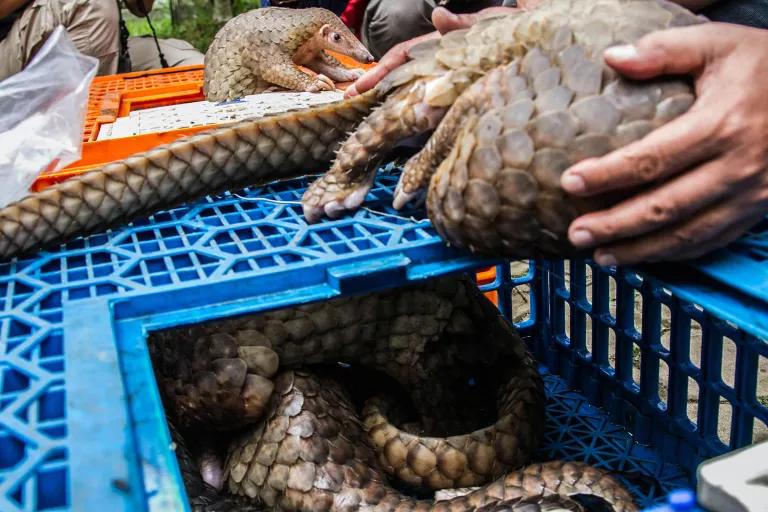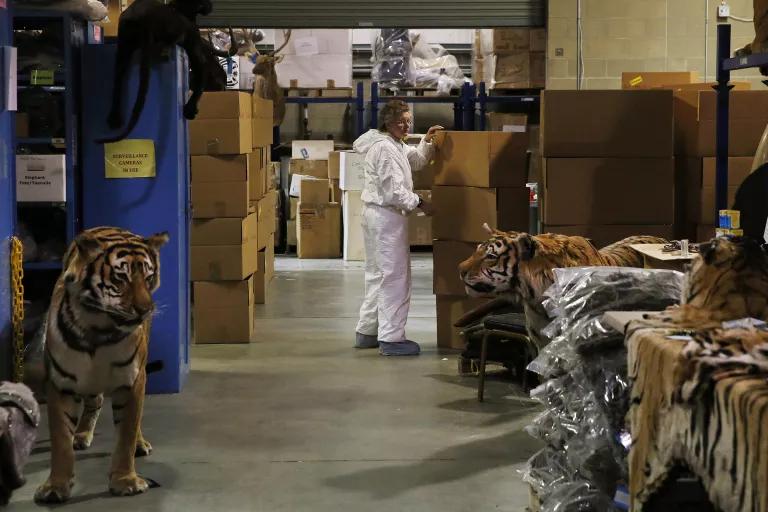These NRDC Experts Show Us How We Can Slow the Spread of Zoonotic Diseases
It will take the highest levels of international cooperation, but by working to curb wildlife trade and conserve vast swaths of disappearing habitat, we can minimize the interspecies interactions that spread viruses.

A security guard stands the Huanan Seafood Wholesale Market in Wuhan, China, where the coronavirus was detected on January 24, 2020
Seventeen years before COVID-19, which is suspected to have emerged from a wildlife market in Wuhan, China, a novel virus called SARS broke out in the Chinese province of Guangdong. It is thought to have jumped from bats to widely traded civet cats and then to humans, going on to kill hundreds before it faded away in the summer of 2003. Six years later, beginning in 2009, hundreds of thousands of people died after contracting the H1N1 virus, which is thought to have originated from a pig farm in Mexico and continues to circulate today as part of our annual flu season. That was not the first time a novel H1N1 virus had swept the globe: In 1918, another H1N1 strain, commonly called the Spanish flu, was thought to have originated in birds—and possibly in the United States—and it infected more than one-third of the world’s human population.
More than 60 percent of emerging infectious diseases originate in animals, and most of those from wild animals. Still, the world continues to eat, use, and trade wildlife, as well as encroach upon their habitats, in ways that make the spread of viruses far more likely. Paul Todd, a senior staff attorney in NRDC’s Nature Program, says this latest pandemic, unprecedented in scale, further underscores the inextricable links between human well-being and the health of wildlife and their habitats. “It’s time we recognize the biodiversity crisis for what it is—an immediate threat to our lives, our economy, and our safety—and begin to act accordingly,” he says.
Todd and his colleagues—Zak Smith and Elly Pepper, director and deputy director, respectively, of international wildlife conservation for NRDC’s Nature Program—are working to help shape United States policy on wildlife trade, as well as advocating through international treaties, to end nearly all commercial wildlife trade. “The bottom line is that wildlife trade is a threat to our public health that only stands to become greater, meaning that we could have greatly reduced the risk of all of this—maybe even prevented it altogether—by stopping wildlife trade,” says Pepper. But it’s an enormous task: Illegal trafficking alone is worth tens of billions of dollars per year and ranges from the breeding of captive tigers for entertainment to the harvesting of pangolin scales for use in traditional medicines. But now, with many global leaders focusing on how to avoid future outbreaks, NRDC is calling on them to move forward with a response commensurate with the threat.

In China, NRDC experts recently got a chance to provide the country’s National Forestry and Grassland Administration with formal recommendations for amending its Wildlife Protection Law, which the government decided to review and modify in response to the COVID-19 crisis. That law dictates which wild species are deemed protected and which ones Chinese residents can eat, own, sell, wear, farm, or hunt. NRDC’s Beijing team also offered the government other policy suggestions on how to reduce the risk of future outbreaks.
As part of these recommendations, Beijing-based NRDC policy analyst Ning (Lisa) Hua and her team proposed that China eliminate a problematic list of more than 100 birds, mammals, amphibians, and insects that can be sold for things like food, medicine, pets, or pelts under the law. Many of the species on that list are not only potential vectors of disease, but also face extinction, such as the spoon-billed sandpiper, the yellow-breasted bunting, and the elongated tortoise—all considered critically endangered by the International Union for Conservation of Nature. The NRDC team recommended these species instead be categorized as protected under the law.
“For some of the species, their population might still be big now, but if commercial use is always allowed or the species isn’t protected under the law, as time goes by, they may become endangered,” Hua says. “We should prevent that from happening.” The recommendations from Hua and her Beijing colleagues also include increased interagency management and enforcement coordination at both the national and provincial levels and more public participation during decision-making processes.
The new wildlife trade ban from China’s top legislature doesn’t address every type of trade; permits can still be obtained to use protected species for making musical instruments and traditional medicines, for example. Still, it marks a significant step forward in the fight against zoonotic diseases and protection of China’s wildlife, Hua says.
The issue of risky wildlife trade—both legal and illegal—extends well beyond China’s borders. Countries like the United States, France, and Italy remain some of the world’s largest consumers of wildlife as food, pets, trophies, fur, and medicine. NRDC has long been working to tackle these markets—work that has only ramped up since the coronavirus crisis shone a light on the wildlife trade’s public health impacts. “To me, that means the United States has an obligation,” says Zak Smith. “If we want to avoid the cost of a future pandemic, then part of that is clamping down on wildlife trade and being willing to invest in that. I can guarantee it’s going to be cheaper than what we’re going through.”

Despite the urgent need for stepped-up conservation measures that could curb trade, the Trump administration continues to attack and undermine critical tools for protecting biodiversity, like the Endangered Species Act (ESA). As more and more animals are taken from the wild for use by people, the risk of zoonotic diseases transferring from wild species to domestic animals and humans only grows, notes Todd. But NRDC, as part of a coalition of environmental groups, is fighting back and recently sued the U.S. Department of the Interior in order to block a significant rollback of the ESA that would allow agencies to insert economic costs into the discussions over a species' listing, and weaken protections for species newly designated as threatened, among other dangerous regulatory changes.
Strengthening international restrictions on wildlife trade in light of COVID-19 is also paramount. For example, NRDC’s international wildlife conservation team is striving to ensure that the Convention on International Trade in Endangered Species of Wild Fauna and Flora (CITES) will be used in new and inventive ways to help address the biodiversity crisis and the pandemic.
Of course, it’s not just smuggling gangs, trophy hunters, and consumers seeking exotic goods who drive the global wildlife trade. Many communities around the world rely on both legal and illegal wildlife trade as critical sources of income and food—and Smith says that we must recognize and work to relieve these economic pressures that drive subsistence hunters and bushmeat sales. Exemptions in trade bans must also be made for wildlife necessary to meeting the nutritional and cultural needs of Indigenous peoples and local communities, notes Pepper.
While local government agencies, community leaders, and businesses must guide the transition away from wildlife-reliant industries and practices, NRDC’s Nature team emphasizes that wealthy countries like the United States that are helping drive demand must commit more resources to supporting these measures. “Shouldn’t the global north itself be doing more with its own capacity to increase, for example, the number of enforcement officers,” Smith says, “or expanding its own ability to examine shipping around the world at ports of entry rather than the ports of exit?”
Around the globe, our encroachment on wildlife habitat—such as clearing intact ecosystems for industrial agriculture or commercial development—is also leading to unprecedented human-wildlife and wildlife-wildlife interactions that can spread disease. “We can chop down rainforests and make them into farmland, but the animals that lived in that forest are then either right there at the edge of that farmland or actually in the farmland itself because there could be trees they still hang out in,” Smith says.
That’s why one of the most significant means of preventing zoonotic disease is, in fact, habitat conservation. Alongside scientists, Indigeneous groups, and partner environmental organizations, NRDC is campaigning to conserve 30 percent of the world’s lands and oceans by 2030. (Though restoration to protect half of the Earth’s wild places will be necessary long-term, Smith notes.)
At least 500,000 of those terrestrial species at risk of extinction are “dead species walking,” Smith says—meaning we currently do not have the habitat to sustain them long-term. “Even if we flipped a switch and stopped converting wild lands, stopped trading wildlife, stopped the kinds of practices that are harming and driving biodiversity loss, we’d still lose those 500,000 species—because what they need to survive is actual restoration of their habitat,” Smith says. “We simply are not setting aside enough representative, meaningful, connected ecosystems around the world to sustain the current level of biodiversity.”
The stakes are high: Intact ecosystems also clean our air and water, support the pollinators that put food on our tables, and sequester the carbon that’s driving climate change. If there’s ever been a time for NRDC to help radically renegotiate our relationship to the natural world and its creatures, it is now.
This NRDC.org story is available for online republication by news media outlets or nonprofits under these conditions: The writer(s) must be credited with a byline; you must note prominently that the story was originally published by NRDC.org and link to the original; the story cannot be edited (beyond simple things such as grammar); you can’t resell the story in any form or grant republishing rights to other outlets; you can’t republish our material wholesale or automatically—you need to select stories individually; you can’t republish the photos or graphics on our site without specific permission; you should drop us a note to let us know when you’ve used one of our stories.


How to Become a Community Scientist
Neonicotinoids 101: The Effects on Humans and Bees
Murder Hornets Are Scary. But Pesticides Are Scarier.